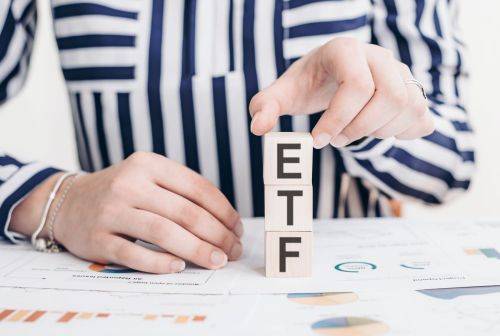Investing isn’t just something people do later in life. In fact, investing is for everyone—the secret is, the younger you are when you learn to invest, the better. Starting to invest as a teen can give them a serious edge because time is on their side.
Don’t take our word for it. Here’s a concrete example: Imagine an 18-year-old is able to start investing $150 a month. If they put that money into an investing account with an average seven per cent annual return, they will have more than $500,000 in 45 years! On the other hand, someone who starts investing the same amount each month at age 30 will have roughly $170,000 by the age of 60. Your teen could end up with nearly three times as much money in the bank, just by getting a head start.
In this investing 101 guide, parents and their teens will learn all about investing for beginners (including the upsides of investing young), how interest rates really add up to your benefit, and how to plan the right mix of investments for your teens’ life goals.
Key takeaways
- Time is the biggest advantage when it comes to investing. The six most common types of investments and funds are: stocks, bonds, TFSAs, mutual funds, ETFs, and GICs.
- Parents can help teach kids how to invest in stocks by setting up a paper trading account to practise without actual stocks.
- Before investing, teens should consider their financial goals, risk tolerance, and timeline.
- Diversification is key: Don’t put all your eggs in one basket.
What is investing?
Simply put, investing is the practice of putting your money into an asset—such as a financial institution, or a government, company, or other type of structure—with the hope of getting back more money than you started with.
It’s also one of the most effective ways to grow wealth and save for bigger, longer-term financial goals. For teens, that may be anything from paying for college or university to travelling abroad for a gap year, buying a car, or eventually purchasing a home.
Why should teens invest early?
Teaching kids about money and investing basics shows them how to spend wisely and make sure enough money is set aside for saving. But the most important reason to get started early is that being young is arguably one of the biggest advantages in investing.
When you’re in your teens or 20s, you can take more risks with longer-term investments that have more growth potential than shorter-term investments. This can help further your wealth.
The magic of compound interest
When you’re young, and time is on your side, you get to take the most advantage of a neat concept called compound interest. Compound interest results in your money growing at a faster rate than your initial investment alone would get you. This is because you earn interest on the money you invest, then you earn interest on that interest. That’s right: You’re making money not just on what you put in, but also what you pick up along the way.
Here’s how compound interest works: Say you have $1,000, and it earns five per cent in interest every year. You’ll have $1,050 at the end of the first year. At the end of year two, you’ll have $1,102.50. Not only did you earn $50 on the initial investment, but you also earned $2.50 on the $50 interest. It might not seem like much at first, but it all adds up over time.
Establishing a habit of investing early has multiple benefits
Starting to invest in your teen years also gives you the advantage of gaining (and then flexing) financial literacy skills sooner rather than later. Understanding how the financial system works and grasping concepts such as saving and budgeting—and even how to manage debt—will help make all those money decisions in life easier to navigate.

What are some common types of investments?
There are many different kinds of investments, so we break down some of the most common ones to help you understand how to start investing in Canada. Here are some common types of investments in Canada that teens should understand, all with varying levels of risk (and potential reward)
1. Stocks
A stock is a unit of ownership in a company, which is bought and sold on a stock exchange (also referred to as the “stock market”). Stocks are also called “shares” or “equities.” When you buy stock, you become a shareholder, which means you actually own a little piece of the company. If profits go up, you reap some of the rewards of those profits. If the company’s profits drop, so does the price of your stock. If you sell your stock on a day when the price of that stock falls below the price you paid for it, you lose money.
Most stocks are considered volatile investments, which means they can have major price swings in short periods of time. To help teens learn how to invest in stocks, parents can set up a paper trading or Practice Account. The purpose of this is to help simulate a stock market environment, so teens can practise investing without purchasing actual stocks.
2. Bonds
A bond is a certificate, or receipt, for a loan you make to a government or company (an issuer). In return for your loan, the issuer of the bond promises to repay the loan on a specific due date and pay you a set rate of interest. Most bonds are low-risk and low-interest, so they may seem kind of boring to teens compared with stocks, but they’re an important part of the investment mix.
You might have heard of a Canada Savings Bond (CSB), which was a type of investment savings product issued and backed by the federal government. The sale of these are no longer available, and all CSBs have been automatically paid out.
3. Tax-Free Savings Account (TFSA)
A TFSA is a way for residents of Canada, over the age of 18, to set aside money, invest it, and watch it grow over their lifetime. Any amount of money put in, as well as any income earned, is generally tax-free, even when withdrawn.
4. Mutual Fund
A mutual fund is a type of investment where the money is pooled together from many investors to buy a set of assets, known as a “portfolio.” This collection of investments could include stocks, bonds, and/or ETFs. A professional money manager oversees the fund and makes decisions about these investments, like when it’s a good time to sell.
5. Exchange-Traded Funds (ETF)
An ETF is a basket of stocks, bonds, or commodities that is bought and sold. They usually track a certain index, sector, commodity, or other asset, but unlike mutual funds, they can be bought, traded, or sold on a stock exchange—just like a regular stock!
Because many brokerages charge for each transaction you make (buying and selling), an ETF is usually a lower-cost option. How so? Well, when making a transaction for a stock, you are doing so for one individual entity, whereas with an ETF, you are doing so for your entire basket—almost like you’re making multiple trades in one.
Most ETFs are also passively managed, meaning there’s no requirement for the active selection of stocks or bonds because they’re usually copying an existing index. This is another contributing factor to their lower cost.
ETFs are typically diversified, so they may be less risky than buying a solo stock, but the risk level ultimately depends on the assets the ETF is made up of. If it contains high-risk stocks, then the risk level will be high and vice versa for low-risk stocks or bonds.
6. Guaranteed Investment Certificate (GIC)
A GIC is a low-risk savings product that is effectively a loan you make to a financial institution, similar to a bond. However, unlike bonds, GICs protect your investment and insure any deposit you make, so you will not lose money on the investment. Interest on GICs can be paid out monthly, quarterly, biannually, annually, or at maturity.
At the end of the term, you’re paid back your full principal, plus any interest still owing. If you withdraw your money early, you might have to pay a penalty. For this reason, you wouldn’t want to invest your money in a GIC if you think you may need to access it in a hurry.
How old do you have to be to invest?
If you’re under the age of majority (18 or 19, depending on which province or territory you’re in), you’ll need a parent or guardian to open an investing account with you. Similarly, for a TFSA, you’ll need to be 18 years of age regardless of where you live in Canada.
Parents can help their tweens and teens learn to invest by helping them set up a virtual paper trading account. Besides helping your child build financial literacy, the account will give your child a good excuse to research stocks and other investments while putting together a portfolio.
If you’re working with a personal financial planner or advisor, include your child in meetings, so they can begin to absorb the process and lingo.

What do you need to consider when investing as a teen?
To make informed investment decisions—regardless of your age—you have to first consider your long-term financial goals and what your investment tolerance or personality is.
Here are some factors to consider when investing.
Risk tolerance
Risk tolerance describes your ability and willingness to handle dips in your investments without constantly worrying about them. There is an old Wall Street adage that says, “You can eat well, or you can sleep well,” which refers to the risk-reward trade-off. Eating well refers to the fact that over long-term horizons, such as decades, having higher-risk assets such as stocks helps investors amass more wealth.
But the volatility of stocks—and dramatic price fluctuations—can make investors lose sleep. If your risk tolerance is low, you might want to hold more bonds. You can also be a more balanced investor by dividing your portfolio into higher- and lower-risk investments, such as stocks and bonds.
Diversification
Speaking of balance, diversification is crucial—i.e., making sure you’re not putting all of your proverbial eggs in one basket. Diversification is the practice of mixing up the assets, so the risk of losing money from one type of asset is limited.
Along with knowing your risk tolerance (a.k.a. comfort level), you also have to factor in how much time you have before you’ll need to cash out those investments. When you’re young, you can make higher-risk investments because you have a long road to retirement.
You have the advantage of handling a certain amount of unpredictability in the short term with the potential for making more money on your investment in the long term. If you invest too conservatively, you can expect to make less money, and your investments might not keep up with the rising cost of living.
Investment Fees
Before you start investing, make sure you understand some of the most common fees associated with buying and selling investments. If you have access to an investment advisor, ask them to explain these to you. If you’re investing solo, take the time to read all the fine print.
- Transaction fees: These are the fees charged when you buy or sell an investment, such as a stock or mutual fund. If you’re investing smaller sums, they can add up. (Bonds work a little differently, and the sales commissions for buying them are often included in the purchase price.) Investment transaction fees for stocks and ETFs in Canada can range anywhere from $9.95 for stocks to more than $35 per trade.
Mutual funds also work a bit differently. With a “front-end load” mutual fund, the fee works out to a percentage of the fund’s purchase (or investment) price, typically up to five per cent. With a “back-end” load, you don’t pay a fee at the time of purchase, but if you cash out your investment earlier than the time limit (say, five to 10 years), you have to pay a type of penalty fee, also usually five per cent. If you invested $1,000, for example, that five per cent fee works out to $50.
- Investment management fees: Investment funds such as mutual funds also charge a fee for managing assets. This fee is called the “management expense ratio,” or MER. Depending on the fund, the fee can range from less than one per cent to more than three per cent of the return. For example, if you have a fund with an annual return of five per cent and the fund’s MER is two per cent, your return would only be three per cent.
If you’re working with a financial advisor, find out how their fees work as well. For example, you may pay an hourly fee for them to help you create a financial plan or a commission if they buy a stock for you.
How much money do you need to start investing as a teen?
You might be surprised to know there is no minimum amount of money needed to start investing. Many banks and brokerages have no account minimums. You can literally invest as little as $5 or $10 every month to start practising and building up that magic of compound interest.
You can even start with as little as $5 a month and work your way up to $5 a week (or more!) over the course of a year. Figuring out your budget, savings, and investment goals will also help you decide how much money you should be putting to work for you.
The bottom line
There are many ways to learn to invest as a young person. If your tween or teen is keen to move from learning about investments to actually putting their money into an investment product, then you might want to consider opening a custodial brokerage account for them. And once your child turns the age of majority, the account can be put in their name. This gives teens the opportunity to practise choosing investments and make real-life decisions to save and grow their money.
Mydoh can also help your teen learn how to earn and save money. With the app, they can earn money through tasks and allowances, and spend it wisely with their Smart Cash Card. Best of all, Mydoh gives parents oversight, so they can keep track of their kids’ progress and spending habits.
Download the Mydoh money app and Smart Cash card for teenagers.
This article offers general information only and is not intended as legal, financial or other professional advice. A professional advisor should be consulted regarding your specific situation. While the information presented is believed to be factual and current, its accuracy is not guaranteed and it should not be regarded as a complete analysis of the subjects discussed. All expressions of opinion reflect the judgment of the author(s) as of the date of publication and are subject to change. No endorsement of any third parties or their advice, opinions, information, products or services is expressly given or implied by Royal Bank of Canada or its affiliates.




















